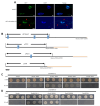The WRKY Family Transcription Factor GmWRKY72 Represses Glyceollin Phytoalexin Biosynthesis in Soybean
- PMID: 39519954
- PMCID: PMC11548433
- DOI: 10.3390/plants13213036
The WRKY Family Transcription Factor GmWRKY72 Represses Glyceollin Phytoalexin Biosynthesis in Soybean
Abstract
Phytoalexins are plant defense metabolites that are biosynthesized transiently in response to pathogens. Despite that their biosynthesis is highly restricted in plant tissues, the transcription factors that negatively regulate phytoalexin biosynthesis remain largely unknown. Glyceollins are isoflavonoid-derived phytoalexins that have critical roles in protecting soybean crops from the oomycete pathogen Phytophthora sojae. To identify regulators of glyceollin biosynthesis, we used a transcriptomics approach to search for transcription factors that are co-expressed with glyceollin biosynthesis in soybean and stilbene synthase phytoalexin genes in grapevine. We identified and functionally characterized the WRKY family protein GmWRKY72, which is one of four WRKY72-type transcription factors of soybean. Overexpressing and RNA interference silencing of GmWRKY72 in the soybean hairy root system decreased and increased expression of glyceollin biosynthetic genes and metabolites, respectively, in response to wall glucan elicitor from P. sojae. A translational fusion with green fluorescent protein demonstrated that GFP-GmWRKY72 localizes mainly to the nucleus of soybean cells. The GmWRKY72 protein directly interacts with several glyceollin biosynthetic gene promoters and the glyceollin transcription factor proteins GmNAC42-1 and GmMYB29A1 in yeast hybrid systems. The results show that GmWRKY72 is a negative regulator of glyceollin biosynthesis that may repress biosynthetic gene expression by interacting with transcription factor proteins and the DNA of glyceollin biosynthetic genes.
Keywords: Glycine max; glyceollin; phytoalexin; transcription factor; transcriptional repressor.
Conflict of interest statement
The authors declare no conflicts of interest.
Figures




Similar articles
-
The NAC family transcription factor GmNAC42-1 regulates biosynthesis of the anticancer and neuroprotective glyceollins in soybean.BMC Genomics. 2019 Feb 20;20(1):149. doi: 10.1186/s12864-019-5524-5. BMC Genomics. 2019. PMID: 30786857 Free PMC article.
-
RNA-Seq Dissects Incomplete Activation of Phytoalexin Biosynthesis by the Soybean Transcription Factors GmMYB29A2 and GmNAC42-1.Plants (Basel). 2023 Jan 25;12(3):545. doi: 10.3390/plants12030545. Plants (Basel). 2023. PMID: 36771629 Free PMC article.
-
Glyceollin Transcription Factor GmMYB29A2 Regulates Soybean Resistance to Phytophthora sojae.Plant Physiol. 2020 Jun;183(2):530-546. doi: 10.1104/pp.19.01293. Epub 2020 Mar 24. Plant Physiol. 2020. PMID: 32209590 Free PMC article.
-
Modulation of phytoalexin biosynthesis in engineered plants for disease resistance.Int J Mol Sci. 2013 Jul 8;14(7):14136-70. doi: 10.3390/ijms140714136. Int J Mol Sci. 2013. PMID: 23880860 Free PMC article. Review.
-
Glyceollin, a soybean phytoalexin with medicinal properties.Appl Microbiol Biotechnol. 2011 Apr;90(1):59-68. doi: 10.1007/s00253-011-3169-7. Epub 2011 Feb 20. Appl Microbiol Biotechnol. 2011. PMID: 21336922 Review.
References
Grants and funding
LinkOut - more resources
Full Text Sources

